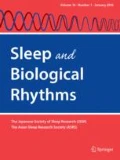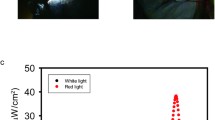Abstract
The influence of light and maternal activity on early infant activity rhythm were studied in 43 healthy, maternal-infant pairs. Aims included description of infant and maternal circadian rhythm of environmental light, assessing relations among of activity and light circadian rhythm parameters, and exploring the influence of light on infant activity independent of maternal activity. Three-day light and activity records were obtained using actigraphy monitors at infant ages 4, 8, and 12 weeks. Circadian rhythm timing, amplitude, 24-h fit, rhythm center, and regularity were determined using cosinor and nonparametric circadian rhythm analyses. All maternal and infant circadian parameters for light were highly correlated. When maternal activity was controlled, the partial correlations between infant activity and light rhythm timing, amplitude, 24-h fit, and rhythm center demonstrated significant relation (r = .338–.662) at infant age 12 weeks, suggesting entrainment. In contrast, when maternal light was controlled there was significant relation between maternal and infant activity rhythm (r = 0.470, 0.500, and 0.638 at 4, 8 and 12 weeks, respectively) suggesting the influence of maternal–infant interaction independent of photo entrainment of cycle timing over the first 12 weeks of life. Both light and maternal activity may offer avenues for shaping infant activity rhythm during early infancy.


Similar content being viewed by others
References
Feldman R. Parent-infant synchrony and the construction of shared timing; physiological precursors, developmental outcomes, and risk conditions. J Child Psychol Psychiatry. 2007;48(3–4):329–54.
Feldman R. From biological rhythms to social rhythms: physiological precursors of mother-infant synchrony. Dev Psychol. 2006;42(1):175–88.
Brooks E, Canal MM. Development of circadian rhythms: role of postnatal light environment. Neurosci Biobehav Rev. 2013;37(4):551–60.
Seron-Ferre M, Torres C, Parraguez VH, Vergara M, Valladares L, Forcelledo ML, et al. Perinatal neuroendocrine regulation. Development of the circadian time-keeping system. MolCell Endocrinol. 2002;186(2):169–73.
Hao H, Rivkees SA. The biological clock of very premature primate infants is responsive to light. Neurobiology. 1999;96:2426–9.
Rivkees SA, Hao H. Developing circadian rhythmicity. Semin Perinatol. 2000;24(4):232–42.
Rivkees SA. Developing circadian rhythmicity in infants. Pediatrics. 2003;112(2):373–81.
Mirmiran M, Maas YG, Ariagno RL. Development of fetal and neonatal sleep and circadian rhythms. Sleep Med Rev. 2003;7(4):321–34.
Seron-Ferre M, Torres-Farfan C, Forcelledo ML, Valenzuela GJ. The development of circadian rhythms in the fetus and neonate. SeminPerinatol. 2001;25(6):363–70.
Joseph D, Chong NW, Shanks ME, Rosato E, Taub NA, Petersen SA, et al. Getting rhythm: how do babies do it? Arch Dis Child Fetal Neonatal Ed. 2015;100(1):F50–4.
Golombek DA, Rosenstein RE. Physiology of circadian entrainment. Physiol Rev. 2010;90(3):1063–102.
Reppert SM, Weaver DR, Rivkees SA, Stopa EG. Putative melatonin receptors in a human biological clock. Science. 1988;242(4875):78–81.
Kennaway DJ. Melatonin and development: physiology and pharmacology. Semin Perinatol. 2000;24(4):258–66.
Kennaway DJ, Goble FC, Stamp GE. Factors influencing the development of melatonin rhythmicity in humans. J Clin Endocrinol Metab. 1996;81(4):1525–32.
Ardura J, Gutierrez R, Andres J, Agapito T. Emergence and evolution of the circadian rhythm of melatonin in children. Horm Res. 2003;59(2):66–72.
Sivan Y, Laudon M, Tauman R, Zisapel N. Melatonin production in healthy infants: evidence for seasonal variations. Pediatr Res. 2001;49(1):63–8.
Rivkees SA, Mayes L, Jacobs H, Gross I. Rest-activity patterns of premature infants are regulated by cycled lighting. Pediatrics. 2004;113(4):833–9.
Brandon DH, Holditch-Davis D, Belyea M. Preterm infants born at less than 31 weeks’ gestation have improved growth in cycled light compared with continuous near darkness. J Pediatr. 2002;140(2):192–9.
Mirmiran M, Ariagno RL. Influence of light in the NICU on the development of circadian rhythms in preterm infants. Semin Perinatol. 2000;24(4):247–57.
Tsai SY, Barnard KE, Lentz MJ, Thomas KA. Twenty-four hours light exposure experiences in postpartum women and their 2–10-week-old infants: an intensive within-subject design pilot study. Int J Nurs Stud. 2009;46:181–8.
Harrison Y. The relationship between daytime exposure to light and night-time sleep in 6–12-week-old infants. J Sleep Res. 2004;13(4):345–52.
Christ E, Korf HW, von Gall C. When does it start ticking? Ontogenetic development of the mammalian circadian system. Prog Brain Res. 2012;199:105–18.
Mistlberger RE, Skene DJ. Social influences on mammalian circadian rhythms: animal and human studies. Biol Rev Camb Philos Soc. 2004;79(3):533–56.
Thomas KA, Burr RL, Spieker S, Lee J, Chen J. Mother-infant circadian rhythm: development of individual patterns and dyadic synchrony. Early Hum Dev. 2014;90(12):885–90.
Thomas KA, Burr RL, Spieker S. Maternal and infant activity: analytic approaches for the study of circadian rhythm. Infant Behav Dev. 2015;41:80–7.
Wright KP Jr, McHill AW, Birks BR, Griffin BR, Rusterholz T, Chinoy ED. Entrainment of the human circadian clock to the natural light-dark cycle. Curr Biol. 2013;23(16):1554–8.
Bonmati-Carrion MA, Arguelles-Prieto R, Martinez-Madrid MJ, Reiter R, Hardeland R, Rol MA, et al. Protecting the melatonin rhythm through circadian healthy light exposure. Int J Mol Sci. 2014;15(12):23448–500.
Duffy JF, Wright KP Jr. Entrainment of the human circadian system by light. J Biol Rhythms. 2005;20(4):326–38.
McMillen IC, Kok JSM, Adamson TM, Deayton JM, Nowak R. Development of circadian sleep-wake rhythms in preterm and full-term infants. Pediatr Res. 1991;29(4):381–4.
Zornoza-Moreno M, Fuentes-Hernandez S, Sanchez-Solis M, Rol MA, Larque E, Madrid JA. Assessment of circadian rhythms of both skin temperature and motor activity in infants during the first 6 months of life. Chronobiol Int. 2011;28(4):330–7.
de Weerth C, Zijl RH, Buitelaar JK. Development of cortisol circadian rhythm in infancy. Early Hum Dev. 2003;73(1–2):39–52.
Acknowledgments
Funded by NICHD R21 HD068597-01A and P30 NR011400.
Author information
Authors and Affiliations
Corresponding author
Ethics declarations
Conflict of interest
The authors have no financial conflict of interest to report.
Rights and permissions
About this article
Cite this article
Thomas, K.A., Burr, R.L. & Spieker, S. Light and maternal influence in the entrainment of activity circadian rhythm in infants 4–12 weeks of age. Sleep Biol. Rhythms 14, 249–255 (2016). https://doi.org/10.1007/s41105-015-0046-2
Received:
Accepted:
Published:
Issue Date:
DOI: https://doi.org/10.1007/s41105-015-0046-2




